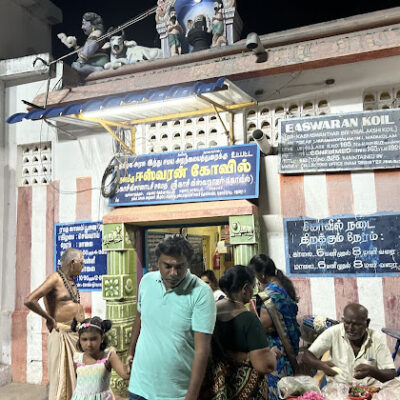Sri Brihadisvara Temple, Thanjavur

Address
Membalam Rd, Balaganapathy Nagar, Thanjavur, Tamil Nadu 613007
Diety
Brihadisvara
Introduction
- Located in Thanjavur, Tamil Nadu, India.
- Built by Raja Raja Chola I between 1003 and 1010 AD.
- A Hindu temple dedicated to Lord Shiva and a prime example of Dravidian architecture.
- Part of the UNESCO World Heritage Site “Great Living Chola Temples,” along with Gangaikonda Cholapuram and Airavatesvara temples.
- Known as Dakshina Meru of the South.
Puranic Significance
- Also called Periya Kovil, Rajarajeswara Temple, or Rajarajeswaram.
- One of the largest temples in India and a hallmark of Chola-era Tamil architecture.
- Built during the reign of Raja Raja Chola I and completed in 1010 AD.
Beliefs
- Rajendra I, the son of Raja Raja Chola, established Gangaikonda Cholapuram as the capital after his Ganges expedition.
- The Gangaikonda Cholapuram temple, along with other temples following Tamil Vastu and Akama Shastra principles, were destroyed in later centuries.
Special Features
- Brihadishvara Temple exemplifies South Indian Chola architectural style, fully realized in scale and detail.
- Built using multifaceted columns with square capitals, signaling a new Chola style.
- Architect: Kunjara Mallan Raja Raja Rama Perunthachan, as per temple inscriptions.
Festivals
- Administered by the ASI, the temple follows traditional daily rituals.
- Rituals include decoration (halibar), food offerings (naveetham), and breathing prayers (aluthratharan).
- Four main rituals take place daily, along with weekly, monthly, and annual festivals.
- Key festivals: Ipsi Poornimaia, Shivarathri, and Kalandir, as well as Annapsekham during the Essential Festival.
- Temple is open daily from 6 am to 12 pm and 4 pm to 9 pm.
Managed By
Tamil Nadu
Nearest Bus Station
Thanjavur
Nearest Railway Station
Thanjavur
Nearest Airport
Trichy




